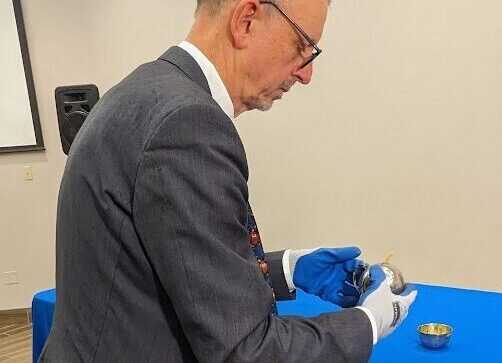A long-lost chapter of the Holocaust found a resolution as silver plundered by the Nazis from Mina and Adolf Ackermann made its way back to London, Ont., the home of their sole surviving child.
A small silver bowl crafted in the 17th century and a ceremonial lamp were two of Mina and Adolf’s cherished possessions, carrying with them not just intrinsic value but also emotional weight.
Like so many artifacts forcibly taken from Jews during the Nazi regime’s systematic plunder of Jewish wealth, the Ackermann silver pieces were once symbols of family heritage and pride.
Amber Lloydlangston, curator of History and Contemporary Culture at Museum London, where the pieces will be held in public trust, sheds light on the tragic tale of Mina and Adolf Ackermann and their silver.
Lloydlangston uncovered a haunting narrative of loss and survival through her research. According to Nazi records, Mina Ackermann complied with the draconian “Third Order” mandating the surrender of precious metals and jewels by Jewish citizens.
In 1939 and 1940, she relinquished the silver pieces to the Municipal Pawn Shop, setting in motion a chain of events that would see them acquired by prominent German institutions.
In 1942, the Ackermanns were deported to the Theresienstadt Work Camp, where Adolf was killed. Mina was moved to Auschwitz in 1944, where she died.
The Ackermanns had two children. Their daughter Lotte, along with her husband, was deported to Kaunas. According to Nazi records, the 27-year-old woman was killed five days after her arrival. The Ackermanns also had a son, Theodore, who was in his mid-30s when his family was murdered.
It can’t be said for certain where Theodore was during the Holocaust, though it is assumed he was living in South Africa at the time with his wife, Ellen.
Lloydlangston described Theodor and Ellen Ackermann’s lives prior to settling in London as “something of an enigma.” However, it is understood by those who knew Theodor that he felt heavily burdened by guilt over his inability to support and protect his family, who suffered unimaginable horrors under the Nazi regime.
Theodore, a scientist, and Ellen forged a new life in London, in the 1970s and spent their remaining years involved in the Jewish community. Theodore died in 1993, and Ellen followed in 2004. They did not have any children.
Now, decades after their passing, the silver that belonged to Theodore’s parents has been returned to his adopted hometown, thanks to the tireless efforts of Matthias Weniger, curator at the Bavarian National Museum in Munich, Germany.

Weniger presented the Ackermann silver to the Jewish London Federation on behalf of the Ackermann estate during a ceremony held April 12 at London’s Jewish Community Centre. After the ceremony, which included an informational presentation from Weniger, the silver was moved to Museum London.
The Ackermann pieces were part of a larger collection of 111 Nazi-looted silver objects once housed at the Bavarian National Museum. Since the inception of their restitution efforts, Weniger and his team have made significant strides, with over half of the stolen items already returned and contact established with all but two families.
For Weniger, this mission is about rectifying past injustices and restoring a sense of dignity and connection to those who were robbed of their heritage.
Bringing the Ackermann silver to London marked Weniger’s first stop on a two-week journey across North America to return ten objects, each laden with its own tale of loss and resilience. Despite the passage of more than eight decades, Weniger remains steadfast in his commitment to seeing these items returned to their rightful owners.
“Of course, heirloom objects such as these pieces of silver should have been returned to families decades ago. I am proud to be now seeing them restored,” Weniger told The CJN.
“For the first time in more than 80 years, candlesticks are being lit for Shabbat, and cups used for Shabbat and Pesach, and it is all very emotional.”
For Eric Robinson, program director at Jewish London, the significance of this act transcends mere material restitution. It symbolizes solidarity and reaffirms the bonds that unite communities in the face of adversity.
“Items like these were elevated to a level of import and likely displayed proudly in the home as an object of pride,” Robinson said, reflecting on the broader implications of Nazi plunder.
“They [objects of value] were stolen under Nuremberg Laws that ebbed away at Jews’ material wealth and well-being in an entirely different way,” he continued, emphasizing the deceptive intent behind laws designed to strip Jews of their possessions and degrade their dignity within society.
The Ackermann silver will be on display at Museum London.
